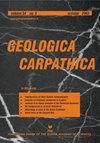Stratigraphical and sedimentological relationships of the Bolognano Formation (Oligocene–Miocene, Majella Mountain, Central Apennines, Italy) revealed by geological mapping and 3D visualizations
IF 1.5
4区 地球科学
Q4 GEOSCIENCES, MULTIDISCIPLINARY
引用次数: 4
Abstract
The characterization and comprehension of buried reservoirs receive remarkable benefits from detailed studies of outcropping analogues which help to define the architecture of the buried sedimentary units and their petrophysical features. In particular, modern 3D techniques of geological data analysis can better constrain the geological mapping process and reveal the geometry of the sedimentary units with complex lateral and vertical relationships. By means of the 3D Move software, we define the sedimentological and stratigraphical relationships between lithostratigraphic units of the Bolognano Formation, outcropping in the northernmost sector of the Majella Mountain (Central Apennines, Italy). The study area belongs to the Apulian carbonate platform and the Majella Mountain represents the northward outcropping portion of its margin. The sedimentary succession of the Majella Mountain consists of Upper Jurassic to upper Miocene limestone and dolostone deposits. In the investigated area, outcropping deposits mainly belong to the Oligo–Miocene Bolognano Formation characterized by five lithofacies associations and representing a carbonate ramp developed in a warm subtropical depositional environment within the oligophotic to aphotic zone. The Bolognano Fm. represents, due to its specific hydraulic properties (e.g. porosity and permeability), an outcropping analogue of worldwide common reservoirs (i.e. porous calcarenite deposits of a carbonate ramp formed by benthic foraminifera such as lepidocyclinids, nummulitids, red algae, corals). In the study area, several geological units of the Bolognano Fm. are characterized by abundant hydrocarbon (bitumen) occurrences infilled within the high-porosity of the cross-bedded calcarenites ascribed to the Chattian and Burdigalian interval. The geological field mapping of the area and the visualization of the geological data in a 3D environment show that the unit formed by mid-ramp calcarenites (Lepidocyclina calcarenites 2 unit, Chattian–Burdigalian) increases in thickness towards the NE (basinward) direction as a consequence of sediment shedding from inner ramp. Our study illustrates how the geological mapping and the visualization and analysis of geological data in a 3D environment of the northernmost sector of the Majella Mountain confirms depositional models of the Bolognano Formation and represents a valid tool for the characterization of the lateral stratigraphic relationships within this formation, and hence of its potential hydrocarbon occurrences.通过地质测绘和3D可视化揭示的Bologano组(渐新世-中新世,意大利亚平宁山脉中部的Majella山)的地层和沉积学关系
对露头类似物的详细研究有助于确定埋藏沉积单元的结构及其岩石物理特征,从而使埋藏储层的表征和理解受益匪浅。特别是,现代三维地质数据分析技术可以更好地约束地质绘图过程,并揭示具有复杂横向和纵向关系的沉积单元的几何形状。通过3D Move软件,我们定义了博洛尼亚诺组岩石地层单元之间的沉积学和地层学关系,该组岩石地层在马耶拉山最北端(意大利亚平宁山脉中部)露头。研究区域属于阿普利亚碳酸盐岩平台,Majella山代表其边缘向北出露的部分。马杰拉山的沉积序列由上侏罗纪到上中新世的石灰岩和白云岩矿床组成。在调查区域内,出露矿床主要属于渐新世-中新世Bologano组,其特征为五个岩相组合,代表在少光-无光带内温暖的亚热带沉积环境中发育的碳酸盐斜坡。由于其特定的水力特性(如孔隙度和渗透率),Bologano组代表了世界常见储层的露头类似物(即由底栖有孔虫形成的碳酸盐斜坡的多孔钙屑岩沉积物,如鳞翅目、nummulitids、红藻、珊瑚)。在研究区域,Bologano组的几个地质单元的特征是,在Chattian和Burdigalian层段的交错层钙质砂屑岩的高孔隙度中填充了丰富的碳氢化合物(沥青)矿点。该区域的地质场测绘和三维环境中地质数据的可视化显示,由于内斜坡的沉积物脱落,由中斜坡钙质砂屑岩形成的单元(Lepidocyclina钙质砂屑石2单元,Chattian–Burdigalian)的厚度向NE(向盆地)方向增加。我们的研究说明了在Majella山最北端的3D环境中进行的地质测绘以及地质数据的可视化和分析如何证实Bologano组的沉积模型,并代表了表征该组内横向地层关系的有效工具,以及因此其潜在的碳氢化合物产状。
本文章由计算机程序翻译,如有差异,请以英文原文为准。
求助全文
约1分钟内获得全文
求助全文
来源期刊

Geologica Carpathica
地学-地球科学综合
CiteScore
2.40
自引率
23.10%
发文量
26
审稿时长
>12 weeks
期刊介绍:
GEOLOGICA CARPATHICA covers a wide spectrum of geological disciplines including geodynamics, tectonics and structural geology, volcanology, stratigraphy, geochronology and isotopic geology, karstology, geochemistry, mineralogy, petrology, lithology and sedimentology, paleogeography, paleoecology, paleobiology and paleontology, paleomagnetism, magnetostratigraphy and other branches of applied geophysics, economic and environmental geology, experimental and theoretical geoscientific studies. Geologica Carpathica , with its 60 year old tradition, presents high-quality research papers devoted to all aspects not only of the Alpine-Carpathian-Balkanian geoscience but also with adjacent regions originated from the Mediterranean Tethys and its continental foreland. Geologica Carpathica is an Official Journal of the Carpathian-Balkan Geological Association.
 求助内容:
求助内容: 应助结果提醒方式:
应助结果提醒方式:


